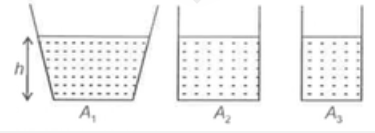The mean pressure on the walls of a vessel containing liquid upto height h is______
To find the mean pressure on the walls of a vessel containing liquid up to height h, we can follow these steps:
Step 1: Understand the Pressure Distribution
In a static liquid, the pressure at any point in the liquid increases with depth. The pressure at the top surface of the liquid (free surface) is zero, and the pressure at the bottom of the liquid column (height h) is given by the formula:
P=ρgh
where:
- P is the pressure at the depth h,
- ρ is the density of the liquid,
- g is the acceleration due to gravity,
- h is the height of the liquid column.
Step 2: Calculate the Pressure at the Top and Bottom
- At the top surface (height = 0):
Ptop=0
- At the bottom surface (height = h):
Pbottom=ρgh
Step 3: Find the Average Pressure
The average pressure on the walls of the vessel can be calculated by taking the average of the pressure at the top and the pressure at the bottom:
Pmean=Ptop+Pbottom2
Substituting the values:
Pmean=0+ρgh2=ρgh2
Conclusion
Thus, the mean pressure on the walls of the vessel containing liquid up to height h is:
ρgh2
---
In a static liquid, the pressure at any point in the liquid increases with depth. The pressure at the top surface of the liquid (free surface) is zero, and the pressure at the bottom of the liquid column (height h) is given by the formula:
P=ρgh
where:
- P is the pressure at the depth h,
- ρ is the density of the liquid,
- g is the acceleration due to gravity,
- h is the height of the liquid column.
- At the top surface (height = 0):
Ptop=0
- At the bottom surface (height = h):
Pbottom=ρgh
The average pressure on the walls of the vessel can be calculated by taking the average of the pressure at the top and the pressure at the bottom:
Pmean=Ptop+Pbottom2
Substituting the values:
Pmean=0+ρgh2=ρgh2
Thus, the mean pressure on the walls of the vessel containing liquid up to height h is:
ρgh2
Topper's Solved these Questions
- BOOK - SL ARORACHAPTER - Mechanical Properties of fluidsEXERCISE - Exercise459videos
Mechanical Properties of fluids
- BOOK - SL ARORACHAPTER - Mathematical toolsEXERCISE - Exercise20videos
Mathematical tools
- BOOK - SL ARORACHAPTER - Mechanical Properties of SolidsEXERCISE - Example113videos
Mechanical Properties of Solids
Similar Questions
Knowledge Check
- Question 1 - Select One
The force on the walls of a vessel of a contained gas is due to
Arepulsive force between gas molecules.Bslight loss in average speed of a gas molecule after collision with wall.Cchange in momentum of a gas molecule due to collision with wall.Delastic collisions between gas molecules. - Question 2 - Select One
The blood pressure exerted on the wall of any blood vessel when the ventricle is contracted is the ________, and the pressure exerted on the wall of any vessel when the heart is relaxed is the ________.
Asystolic pressure, diastolic pressureBdiastolic pressure, systolic pressureCsphygmomanomic pressure, blood pressureDventricular pressure, auricular pressure. - Question 3 - Select One
There is a small hole in the bottom of a fixed container containing a liquid upto height 'h'. The top of the liquid as well as the hole at the bottom are exposed to atmosphere. As the liquid come out of the hole. (Area of the hole is 'a' and that of the top surface is 'A') :
Athe top surface of the liquid accelerates with acceleration =gBthe top surface of the liquid accelertes with acceleration =g'a2A2Cthe top surface of the liquid retards with retardation =g'aADthe top surface of the liquid retards with retardation =ga2A2
Give reason for the following :
(a) Gases fill up completely the vessel in which they are kept.
(b) Gases exert pressure on the walls of the containing vessel.View SolutionThere is a hole of area 125cm2 in the bottom of a cylindrical vessel containing fluid up to height h. The liquid flows out in time t. If the liquid were filled in the vessel up to height 4h, then it would flow out in time
View SolutionThe shape of the vessel containing the liquid does not affect the pressure. This is known as
View SolutionThe vapour pressure of a liquid in a closed container depends upon
View SolutionThe pressure exerted by a liquid of height h is given by(symbols have their usuall meanings)
View Solution

